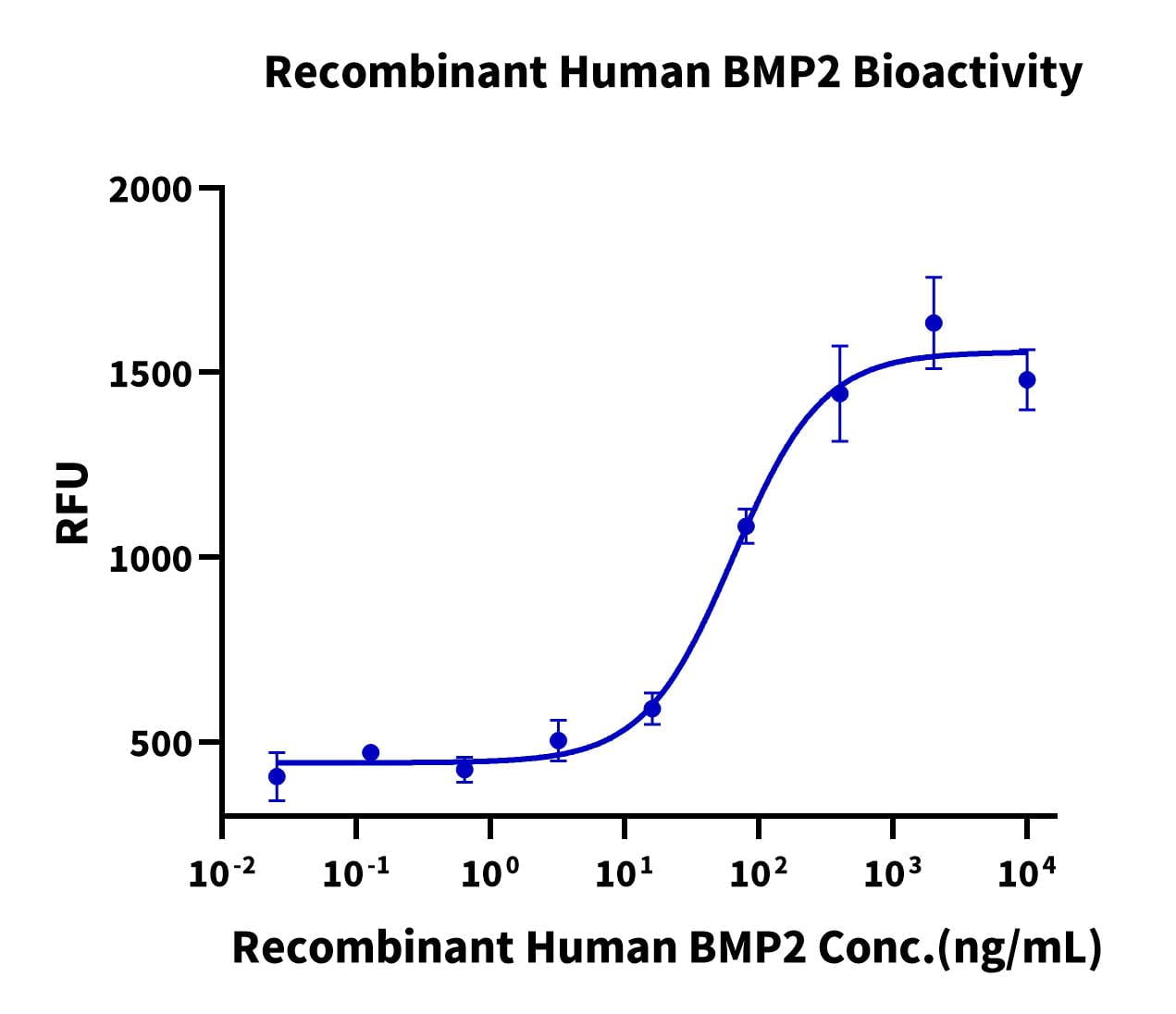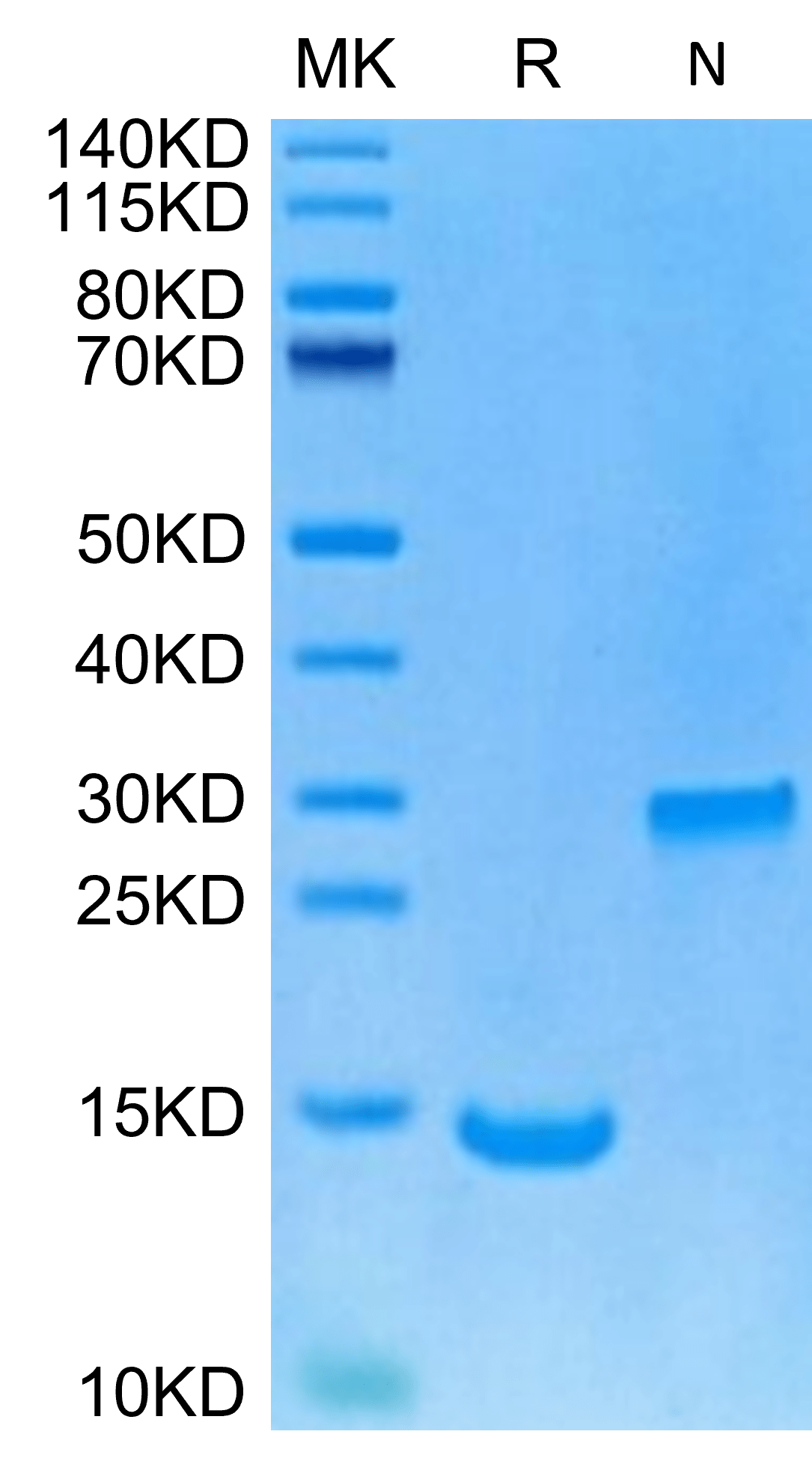| Weight | 1 lbs |
|---|---|
| Dimensions | 9 × 5 × 2 in |
| accession | P12643 |
| express system | E.coli |
| product tag | No Tag |
| purity | > 95% as determined by Tris-Bis PAGE |
| background | Bone morphogenetic protein 2 (BMP2), a member of the transforming growth factor-β (TGF-β) super-family, is one of the main chondrogenic growth factors involved in cartilage regeneration. BMP2 is known to induce chondrogenic differentiation in various types of stem cells in vitro. However, BMP2 also induces osteogenic differentiation and endochondral ossification in mesenchymal stem cells (MSCs). |
| molecular weight | The protein has a predicted MW of 12.90 kDa same as Tris-Bis PAGE result. |
| available size | 100 µg, 500 µg |
| endotoxin | Less than 0.2EU per μg by the LAL method. |
Human/Rhesus macaque/Mouse/Rat/Canine BMP2 Protein 2988
$255.00 – $850.00
Summary
- Expression: E.coli
- Active: Yes (cell based assay)
- Amino Acid Range: Gln283-Arg396
Human/Rhesus macaque/Mouse/Rat/Canine BMP2 Protein 2988
| protein |
|---|
| Size and concentration 100, 500µg and lyophilized |
| Form Lyophilized |
| Storage Instructions Valid for 12 months from date of receipt when stored at -80°C. Recommend to aliquot the protein into smaller quantities for optimal storage. Please minimize freeze-thaw cycles. |
| Storage buffer Shipped at ambient temperature. |
| Purity > 95% as determined by Tris-Bis PAGE |
| target relevance |
|---|
| Bone morphogenetic protein 2 (BMP2), a member of the transforming growth factor-β (TGF-β) super-family, is one of the main chondrogenic growth factors involved in cartilage regeneration. BMP2 is known to induce chondrogenic differentiation in various types of stem cells in vitro. However, BMP2 also induces osteogenic differentiation and endochondral ossification in mesenchymal stem cells (MSCs). |
| Protein names Bone morphogenetic protein 2 (BMP-2) (Bone morphogenetic protein 2A) (BMP-2A) |
| Gene names BMP2,BMP2 BMP2A |
| Protein family TGF-beta family |
| Mass 9606Da |
| Function Growth factor of the TGF-beta superfamily that plays essential roles in many developmental processes, including cardiogenesis, neurogenesis, and osteogenesis (PubMed:18436533, PubMed:24362451, PubMed:31019025). Induces cartilage and bone formation (PubMed:3201241). Initiates the canonical BMP signaling cascade by associating with type I receptor BMPR1A and type II receptor BMPR2 (PubMed:15064755, PubMed:17295905, PubMed:18436533). Once all three components are bound together in a complex at the cell surface, BMPR2 phosphorylates and activates BMPR1A (PubMed:7791754). In turn, BMPR1A propagates signal by phosphorylating SMAD1/5/8 that travel to the nucleus and act as activators and repressors of transcription of target genes. Also acts to promote expression of HAMP, via the interaction with its receptor BMPR1A/ALK3 (PubMed:31800957). Can also signal through non-canonical pathways such as ERK/MAP kinase signaling cascade that regulates osteoblast differentiation (PubMed:16771708, PubMed:20851880). Also stimulates the differentiation of myoblasts into osteoblasts via the EIF2AK3-EIF2A-ATF4 pathway by stimulating EIF2A phosphorylation which leads to increased expression of ATF4 which plays a central role in osteoblast differentiation (PubMed:24362451). Acts as a positive regulator of odontoblast differentiation during mesenchymal tooth germ formation, expression is repressed during the bell stage by MSX1-mediated inhibition of CTNNB1 signaling (By similarity). |
| Subellular location Secreted. |
| Tissues Particularly abundant in lung, spleen and colon and in low but significant levels in heart, brain, placenta, liver, skeletal muscle, kidney, pancreas, prostate, ovary and small intestine. |
| Structure Homodimer; disulfide-linked (PubMed:10074410). Interacts with SOSTDC1 (PubMed:15020244). Interacts with GREM2, RGMA, RGMB and RGMC. Interacts with ASPN (By similarity). Interacts with MAFP5 (By similarity). Interacts with FBN1 (via N-terminal domain) and FBN2 (PubMed:18339631). Interacts with type I receptor BMPR1A (PubMed:15064755). Interacts with type II receptor BMPR2 (PubMed:7791754). Interacts with SCUBE3 (PubMed:33308444). Interacts with TNFAIP6 (primarily via Link domain); this interaction is inhibited by hyaluronan. Interacts with ERFE (PubMed:31800957). Interacts with BMPR1A/ALK3; the interaction may induce HAMP expression (PubMed:31800957). Forms heterodimers with BMP6 in vitro; the heterodimer then binds to its receptor BMPR1A /ALK3 and may induce HAMP expression (PubMed:31800957). |
| Target Relevance information above includes information from UniProt accession: P12643 |
| The UniProt Consortium |
Data
Publications
Publications
| pmid | title | authors | citation |
|---|---|---|---|
| We haven't added any publications to our database yet. | |||
Protocols
| relevant to this product |
|---|
Documents
| # | ||
|---|---|---|
| Please enter your product and batch number here to retrieve product datasheet, SDS, and QC information. | ||
















